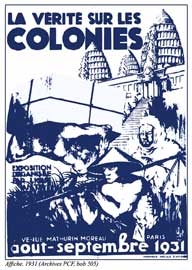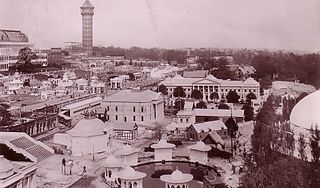
The Crystal Palace was a cast iron and plate glass structure, originally built in Hyde Park, London, to house the Great Exhibition of 1851. The exhibition took place from 1 May to 15 October 1851, and more than 14,000 exhibitors from around the world gathered in its 990,000 square feet (92,000 m2) exhibition space to display examples of technology developed in the Industrial Revolution. Designed by Joseph Paxton, the Great Exhibition building was 1,851 feet (564 m) long, with an interior height of 128 feet (39 m), and was three times the size of St Paul's Cathedral.

The Great Exhibition of the Works of Industry of All Nations, also known as the Great Exhibition or the Crystal Palace Exhibition, was an international exhibition which took place in Hyde Park, London, from 1 May to 15 October, 1851. It was the first in a series of World's Fairs, exhibitions of culture and industry that became popular in the 19th century. The event was organised by Henry Cole and Prince Albert, husband of Victoria, Queen of the United Kingdom.

The Delhi Durbar was an Indian imperial-style mass assembly organized by the British at Coronation Park, Delhi, India, to mark the succession of an Emperor or Empress of India. Also known as the Imperial Durbar, it was held three times, in 1877, 1903, and 1911, at the height of the British Empire. The 1911 Durbar was the only one that a sovereign, George V, attended. The term was derived from the common Mughal term durbar.

The All Red Line was an informal name for the system of electrical telegraphs that linked much of the British Empire. It was inaugurated on 31 October 1902. The name derives from the common practice of colouring the territory of the British Empire red or pink on political maps.

The British Empire Exhibition was a colonial exhibition held at Wembley Park, London England from 23 April to 1 November 1924 and from 9 May to 31 October 1925.

Sir George Watt was a Scottish physician and botanist who worked in India as "Reporter" on economic botany and during the course of his career in India he compiled a major multivolume work, TheDictionary of Economic Products of India, the last volume of which was published in 1893. An abridged edition of his work was also published as the single volume Commercial Products of India in 1908. He is honoured in the binomials of several plants named after him.

Valentine Cameron "Val" Prinsep was a British painter of the Pre-Raphaelite school.

A colonial exhibition was a type of international exhibition that was held to boost trade. During the 1880s and beyond, colonial exhibitions had the additional aim of bolstering popular support for the various colonial empires during the New Imperialism period, which included the scramble for Africa.

The Colonial and Indian Exhibition of 1886 was held in South Kensington in London with the objective to "stimulate commerce and strengthen the bonds of union now existing in every portion of her Majesty's Empire". The exhibition was opened by Queen Victoria, and when it closed had received 5.5 million visitors.

Empire Exhibition, Scotland 1938 was an international exposition held at Bellahouston Park in Glasgow, from May to December 1938.
John Golding Myers was a British entomologist and botanist. Born near Rugby, Warwickshire, he worked in New Zealand on biological control, followed by work in the UK, the Caribbean and Latin America before moving to Sudan as Government Botanist. He died in Sudan at the age of 44.

Frederick Vincent Theobald FES was an English entomologist and "distinguished authority on mosquitoes". During his career, he was responsible for the economic zoology section of the Natural History Museum, London, vice-principal of the South-Eastern Agricultural College at Wye, Kent, Professor of Agricultural Zoology at London University, and advisory entomologist to the Board of Agriculture for the South-Eastern district of England. He wrote a five volume monograph and sixty scientific papers on mosquitoes. He was recognised for his work in entomology, tropical medicine, and sanitation; awards for his work include the Imperial Ottoman Order of Osmanieh, the Mary Kingsley Medal, and the Victoria Medal of Honour, as well as honorary fellowships of learned societies.

The 1911 Festival of Empire was the biggest single event held at The Crystal Palace in London since its opening. It opened on 12 May and was one of the events to celebrate the coronation of King George V. The original intention had been that Edward VII would open it in 1910, however, this was postponed after his death shortly before the planned opening day. The Festival contained a display of landscapes and exhibits from the British Empire, mainly the dominion countries, to encourage emigration to those nations; and it contained a large scale pageant dramatising British history. It was described at the time as ‘a social gathering of the British family’ encouraging the ‘firmer welding of those invisible bonds which hold together the greatest empire the world has ever known’. It has since been described as the ‘ultimate imperialist propaganda showcase’.
The Pageant of Empire was name given to various historical pageants celebrating the British Empire which were held in Britain during the early twentieth century. For example there was a small Pageant of Empire at the town of Builth Wells in 1909. In 1911 a giant Pageant of Empire took place at the Festival of Empire at the Crystal Palace in Sydenham, where thousands of amateur performers acted out historical scenes The most notable was the Pageant of Empire which took place in London in 1924.

Sir Caspar Purdon Clarke was an English architect and museum director.

The Stanley Cycle Show or Stanley Show was an exhibition of bicycles and tricycles first mounted by the Stanley Cycling Club in 1878 at The Athenaeum in London's Camden Road. Britain's first series production cars were displayed at this show in November 1896. The 34th and last exhibition was held in the Royal Agricultural Hall, Islington in November 1910. It was supplanted by the 1911 Olympia Motor Cycle Show and, a few weeks before that, Olympia's International Motor Exhibition.

Frank Cundall FSA, FRHS, OBE, was an English art historian, editor and author, the son of the writer and publisher Joseph Cundall. He was closely involved in the administration of and produced the reports for a series of international exhibitions held in London in the 1880s, and catalogued the art library at the South Kensington Museum, later the Victoria and Albert Museum.

The Colonial Defence Committee (CDC) was a standing committee of the British Colonial Office between 1885 and 1908. During the second half of the 19th century British Army troops were being progressively withdrawn from colonial garrisons, with the intention being that colonial governments would replace them with locally raised troops. Russian victory in the 1877–1878 Russo-Turkish War led to increased concerns for the security of the British colonies and a short-term Royal Commission looked into colonial defence. It was replaced by the CDC, which first met on 22 April 1885.

The 1895 African Exhibition at The Crystal Palace was an instance of a human zoo in London. The colonial exhibition presented around eighty people brought from Somalia along with two-hundred African animals.

















